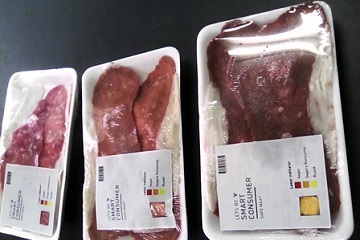IPB Researchers Created Smart Label to Detect Bacterial Pathogens

Meat and fish products are food products that are particularly vulnerable to damage by microorganisms. Food spoilage is a metabolic process that causes foods to be undesirable or unacceptable for human consumption due to changes in sensory characteristics. Many types of microorganisms can cause food problems. The microorganisms that can cause food-borne illness are called pathogenic microorganisms. The growth of bacteria in meat, especially pathogenic bacteria can cause damage to the product. Not only that, meat or fish that have been contaminated pathogenic bacteria are also not safe to eat because it can cause disease. Bacterial contamination is more dangerous because very often food does not look bad even though severely infected, it may appear quite normal. The presence of highly dangerous toxins and bacterial spores is often not detected until after an outbreak of food poisoning, laboratory examination uncovers the infecting agent. The pathogenic bacteria that harm consumers are Escherichia coli, Salmonella typhimurium and Staphylococcus aureus where they can often be found growing on the surface of foods when air is present.
Based on the difficulty of consumers tracing the feasibility of meat and fish, a team of researchers from the Bogor Institute of Agriculture (IPB) developed the " Label Cerdas Pendeteksi Bakteri Patogen Daging = Intelligent Label for Pathogenic Detection". The researchers were Dr. Ir. Endang Warsiki and Dr.Ir. Mulyorini Rahayuningsih from the Department of Industrial Technology of Agriculture, Faculty of Agricultural Technology (FATETA).
This label was created to provide information on the presence of pathogenic bacteria as indicated by the colour change of the label. Labels are made of polymer material and certain selective media according to the bacteria you want to indicate. This innovated label uses a simple and inexpensive system compared to other devices.
"The label can be directly attached to the inside of the package which will response immediately food deterioration progress by color-changing," said Dr. Endang.
The label, which would appear on the packaging, also could be used to determine if foods and other perishable products were still active or fresh. The colour of the indicator are red brick to yellow colour. This color-coded smart label could tell consumers whether the meat or fish product is still in good condition without opening the containers, according to researchers. When the indicator label has turned red brick means the products are still in good condition. When the products are in the process of spoilage, the colour coded has turned into to orange, they have to be consumed immediately as they nearly spoil. Meanwhile, if the products have spoiled the label will turn into yellow.
The results showed that Escherichia coli has turned the colour of the label from orange to pink. Further Salmomella typhimurium can be detected when the brown colour turned into pink, and the presence of Staphylococcus aureus will be detected when the detection label turn into black colour on the label.
"The labels can be “blends” of more than one material, such as powder, tapioca, sugar, salt and other nutritional ingredients as well as red venol red dye. The mechanism process is based on the volatile of acid gas and acid compounds from bacterial metabolism. Scientifically, bacteria produce protease enzymes that can break down proteins in meat into simpler compounds, namely volatile acid gases. When meat is contaminated, then the air in the container will also be contaminated causing bacteria to penetrate the label and contaminate the label. Fermentation of sugar by bacteria in the contaminated label occur, and will produce acid. Acid and gases are ingredients that turn the color of the label into yellow, "he said.
Commercial applications of this label will greatly help producers and consumers to recognize the quality of meat and processed products quickly and practically. The advantage for producers or merchants who use this label on their products, they cultivate customer trust from the consumers of the quality of the products. In addition, the product feasibility test can be carried out quickly as they do not need laboratory works. Simple and low costs production enable the labels will easily be produced. (Wied)



